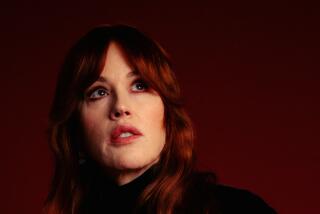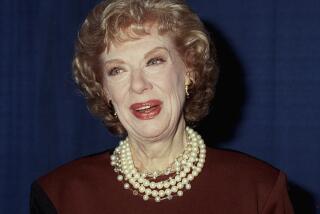From the Archives: ‘Honeymooners’ Sidekick Art Carney Dies
- Share via
Art Carney, who won a best-actor Oscar for “Harry and Tonto” and originated the role of fussy Felix Ungar in “The Odd Couple” on Broadway, but who is best remembered as Jackie Gleason’s lovable sewer-worker pal Ed Norton on television’s “The Honeymooners,” has died. He was 85.
Carney, a versatile stage, screen and television actor who was equally adept at comedy and drama, died Sunday after a long illness. The family would not specify the illness or say where Carney, a longtime resident of Westbrook, Conn., had died.
Carney won his Academy Award in the 1974 film playing Harry, a retired teacher and widower who sets off on a cross-country journey with Tonto, his cat, after his New York apartment building is torn down.
But even after winning Hollywood’s top acting prize for his first starring film role, Carney said people still greeted him with, “How are things down in the sewer?”
“Not that I ever regret playing Ed Norton,” said Carney, who got his acting start on radio in the early 1940s and made his TV debut in 1948.
There’s no denying the impact Norton, the self-described “subterranean sanitation engineer,” had on Carney’s career.
“He was the show, because he was so inventive,” comedian Sid Caesar, who worked with Carney on some TV specials, told The Times on Tuesday. “I admired him very, very much. He was a huge talent.”
Carney won Emmys for best supporting actor in 1953, 1954 and 1955 for playing Norton in “The Honeymooners” sketches on “The Jackie Gleason Show.” As Carney said later, “I brought the sewer worker to life.”
Clad in his trademark T-shirt, open vest and beat-up felt hat with upturned brim — a hat Carney paid $5 for in 1935 while still in high school — he became one of the most enduring second-bananas in TV history.
Carney viewed his lovable, dim-bulb Norton and Gleason’s blustery bus driver Ralph Kramden as a Brooklyn version of Stan Laurel and Oliver Hardy.
He told the Toronto Star in 1987 that Norton and Kramden’s relationship “was crude in a way — with that [kitchen] set and everything; the pan under the icebox. You had to imagine what the bedroom looked like.”
Once, he said, when Norton’s apartment was shown, it had a leopard-skin spread on the bed and a horse with a clock in its stomach that he’d won in Coney Island.
“Norton certainly had the better apartment,” Carney said. “Of course, he bought everything on time — he bought his newspapers on time.”
One classic Norton moment comes when Ralph is trying to learn to play golf and Norton is reading from a book on how to execute a proper swing: “First step up, plant your feet firmly and address the ball.”
What do they mean “address” the ball? Ralph asks.
“Wait a minute, I think I know what it means,” Norton says, taking the club out of Ralph’s hand. He then steps up, plants his feet firmly, offers an arm-waving salute and says, “Hellooooo, ball!”
Norton never failed to exasperate his pal “Ralphie boy” with his arm-flailing, time-consuming flourishes whenever he had to sign a piece of paper.
Carney stumbled on the signature piece of business in rehearsal one day, when he simply embellished something his father had done whenever he had to sign young Art’s report card. The senior Carney would make sure the light was just right, move objects around on the table, shoot his arms out, check the pen and line up the paper just so.
“I’d say, ‘Papa, just sign the card and let me go back to school,’ ” Carney recalled.
At the rehearsal, Gleason told him, “Whatever you’re doing, keep it in.”
Thanks to reruns of one of the most popular comedies from TV’s Golden Age, Norton likely will continue to be the one role Carney is most associated with.
“If you look back on ‘The Honeymooners,’ there’s Jackie Gleason, the bombastic, overstating, larger-than-life character; and here’s Ed Norton, a realistic, down-to-earth Everyman,” said Michael Marsden, professor of English and cultural studies at Eastern Kentucky University and co-editor of the Journal of Popular Film and Television.
“He’s a perfect counterbalance to this huge overstatement.”
Carney’s passing leaves only Joyce Randolph, who played Norton’s wife, Trixie, among the 1950s situation comedy’s quartet of co-stars. Gleason died in 1987, and Audrey Meadows, his TV wife, Alice, died in 1996.
“Art gained most of his fame playing Ed Norton because he was so amazingly funny,” Randolph told The Times on Tuesday. “He was just a natural. And Jackie could not have done the show without Art Carney and even said so.
“They were like Laurel and Hardy and, in fact, once in a while they played Laurel and Hardy in rehearsal, and they were very funny.”
Arthur William Matthew Carney was born Nov. 4, 1918, in Mount Vernon, N.Y., the youngest of six sons of newspaperman-publicist Edward Carney and Helen Carney.
Although quiet and introverted, Carney was a born mimic who by grade school was entertaining family members with his impressions of everyone from Edward G. Robinson to Franklin D. Roosevelt.
By high school, Carney was entertaining at school dances and for civic organizations with an act that consisted of a tap-dancing routine and his imitations. He also won amateur contests with his impersonations and was named “Wittiest Boy” in his yearbook.
His impressions were so good that, after graduating in 1937, he was hired to join the Horace Heidt dance band. Carney’s oldest brother, Jack, then an agent for Music Corp.of America, arranged the audition with Heidt, who hired Carney on the spot.
On the road with the band, Carney did his impressions, sang novelty songs and served as announcer for Heidt’s “Pot o’ Gold” radio program.
In 1940, while still with the band, Carney married his high school sweetheart, Jean Myers. They had three children.
While working with Heidt, Carney also began drinking — something that would later cause problems in both his personal and professional life, as would bouts of depression.
Carney quit the Heidt band in 1941 after showing up too drunk to announce the radio show. His condition became all too apparent when he couldn’t spell Tums, the sponsor’s name, on the air. He quit before being fired at the sponsor’s insistence.
After leaving Heidt, Carney experienced a lean period in which he worked sporadically in nightclubs and on the vaudeville circuit. Radio proved to be his professional salvation.
In 1942, his brother Jack steered him to CBS, which was hiring actors for “Report to the Nation,” a weekend news program that re-created current events with actors imitating the voices of world leaders. Carney became one of the show’s regulars, providing the voices of everyone from FDR to Winston Churchill.
Carney’s success on the show led to radio acting jobs on soap operas, comedies, dramas and children’s shows. But his steady work on radio came to a halt in the spring of 1944 when he was drafted into the Army.
Arriving in France two months after D-day, he had just set up his machine gun and was filling his canteen with water when a piece of shrapnel from an enemy mortar round ripped into his right thigh.
Carney spent the next nine months in a military hospital. The wound permanently shortened his right leg by three-fourths of an inch, causing him occasional pain and a slight limp the rest of his life.
After his discharge, Carney returned to CBS Radio, where he became second banana for the likes of Milton Berle, Bert Lahr, Edgar Bergen and Fred Allen.
In 1948, he joined “The Morey Amsterdam Show,” playing Charlie, the dumb doorman in the program’s New York nightclub setting.
When the show moved from CBS Radio to the DuMont television network, Carney moved with it. TV audiences got their first glimpse of Carney on the show as the recurring character of Newton, a goofy waiter who wore a thick, Chaplinesque mustache and parted his slicked-back hair in the middle.
The scene-stealing character, known for his machine-gun laugh (“Ha! Ha! Ha!”) and his signature “Va, va, va, voom!” whenever he saw a pretty girl, gave Carney his first TV fame.
In 1950, he began his association with Gleason, the new host of “Cavalcade of Stars,” a big-budget comedy-variety show on DuMont.
Carney originally played dozens of walk-on roles and character parts in Gleason sketches. He then began playing a number of regular characters.
“The Honeymooners” sketches were introduced in 1951.
“I became Norton, the one guy in the world who was even dumber than Ralph Kramden, the boob Gleason played,” Carney recalled. “I liked it because I could be myself, make mistakes in grammar, and be comfortable.”
When Gleason moved his variety show to CBS in 1952, “The Honeymooners” became the show’s main sketch for the next three years. “The Honeymooners” then ran as a 39-episode, half-hour series from 1955 to 1956 before returning as a sketch for one season on the new “Jackie Gleason Show.”
Carney said later that he and Gleason never had a cross word with each other.
Years later, on the set of the comedy “Izzy and Moe,” a 1985 CBS-TV movie co-starring Gleason and Carney as Prohibition-era federal agents, Gleason generously gave Carney “90% of the credit” for the success of “The Honeymooners.”
“He has exquisite timing — and the best body language in the world,” Gleason told People magazine.
The introverted Carney said he always wanted to be like Ed Norton. “Ed was friendly and outgoing, and nothing seemed to bother him,” he told People magazine in 1985. “For me, that was all acting.”
Indeed, in a 1954 interview, Carney said he didn’t consider himself a comedian.
“I don’t tell jokes, and if I tried, I couldn’t hold an audience’s attention for five minutes,” he said. “I’m an actor, playing a comic role in a situation comedy.”
Carney demonstrated his acting range during and after his Gleason years by appearing in dramatic productions on “Playhouse 90,” “Studio One” and “Kraft Television Theatre.”
In 1957, he made his Broadway debut in “The Rope Dancers,” a drama in which he played an alcoholic, ineffectual husband and father in turn-of-the century New York. Other stage productions followed, including the 1961 Broadway comedy “Take Her, She’s Mine.”
Carney also starred in TV productions of “Harvey,” “Our Town” and “The Right Man” and played an alcoholic character depressed over his divorce in “Call Me Back” on NBC in 1960.
The latter character was an all too prophetic one for Carney. By 1965, despite his success in Neil Simon’s hit Broadway play “The Odd Couple,” playing the meticulous Felix Ungar opposite Walter Matthau’s slovenly Oscar Madison, Carney was on a personal downward slide.
That October, Carney, suffering what he later called a mental and physical breakdown, dropped out of “The Odd Couple” and checked into a psychiatric center in Hartford, Conn.
“My first marriage was breaking up and I was not in good shape, physically or mentally,” Carney told The Times in 1974. “I was hurt by my troubles with alcohol.”
Carney later credited Ed Norton with saving his life. Gleason brought him out of the hospital to do a “Honeymooners’ Special” on “The Jackie Gleason Show.”
The special was such a hit that a revived “Honeymooners,” with Sheila MacRae as Alice and Jane Kean as Trixie, continued on the Gleason show for the next four years and earned Carney his fourth and fifth Emmy awards.
A few years later, Carney would revive his movie career, which had consisted of a few bit parts and cameos, by taking the lead role in “Harry and Tonto.”
He initially resisted taking the part when writer-director Paul Mazursky approached him. At 54, Carney felt he was too young to play the 72-year-old Harry — despite his own balding head, his hearing aid for a hereditary ear problem and his limp. But his longtime agent-manager Bill McCaffrey told him: “Do it. You are old.”
Carney won the Oscar for best actor over stiff competition: Jack Nicholson (“Chinatown”), Al Pacino (“The Godfather Part II”), Dustin Hoffman (“Lenny”) and Albert Finney (“Murder on the Orient Express”).
Even director Mazursky didn’t think Carney would win. Not that he didn’t think Carney delivered an Oscar-caliber performance.
“He’s a master — one of the great actors of our time,” Mazursky told Entertainment Weekly in 2000. “But once he played Ed Norton, it’s hard to see him as something else.”
Among Carney’s later films were “The Late Show,” a 1977 detective story co-starring Lily Tomlin; and “Going in Style,” a 1979 comedy in which Carney, George Burns and Lee Strasberg played three elderly friends living on Social Security who decide to escape their tedious lives by robbing a bank. His final feature appearance was in “The Last Action Hero” in 1993.
Carney and his first wife were divorced in 1965. In 1966, he married Barbara Isaac. They divorced 10 years later, and Carney remarried his first wife in 1977.
He is survived by his wife, Jean; his sons, Brian, of North Salem, N.Y., and Paul, of Westbrook, Conn.; his daughter, Eileen, of Old Saybrook, Conn.; his brother, Fredrick, of New Jersey; six grandchildren; and one great-grandson.
A private funeral service was held Tuesday.
More to Read
Start your day right
Sign up for Essential California for the L.A. Times biggest news, features and recommendations in your inbox six days a week.
You may occasionally receive promotional content from the Los Angeles Times.






